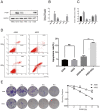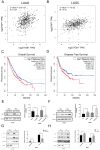ITGB1 enhances the Radioresistance of human Non-small Cell Lung Cancer Cells by modulating the DNA damage response and YAP1-induced Epithelial-mesenchymal Transition
- PMID: 33613118
- PMCID: PMC7893583
- DOI: 10.7150/ijbs.52319
ITGB1 enhances the Radioresistance of human Non-small Cell Lung Cancer Cells by modulating the DNA damage response and YAP1-induced Epithelial-mesenchymal Transition
Abstract
Objectives: Radiotherapy has played a limited role in the treatment of non-small cell lung cancer (NSCLC) due to the risk of tumour radioresistance. We previously established the radioresistant non-small cell lung cancer (NSCLC) cell line H460R. In this study, we identified differentially expressed genes between these radioresistant H460R cells and their radiosensitive parent line. We further evaluated the role of a differentially expressed gene, ITGB1, in NSCLC cell radioresistance and as a potential target for improving radiosensitivity. Materials and Methods: The radiosensitivity of NSCLC cells was evaluated by flow cytometry, colony formation assays, immunofluorescence, and Western blotting. Bioinformatics assay was used to identify the effect of ITGB1 and YAP1 expression in NSCLC tissues. Results: ITGB1 mRNA and protein expression levels were higher in H460R than in the parental H460 cells. We observed lower clonogenic survival and cell viability and a higher rate of apoptosis of ITGB1-knockdown A549 and H460R cells than of wild type cells post-irradiation. Transfection with an ITGB1 short hairpin (sh) RNA enhanced radiation-induced DNA damage and G2/M phase arrest. Moreover, ITGB1 induced epithelial-mesenchymal transition (EMT) of NSCLC cells. Silencing ITGB1 suppressed the expression and intracellular translocation of Yes-associated protein 1 (YAP1), a downstream effector of ITGB1. Conclusions: ITGB1 may induce radioresistance via affecting DNA repair and YAP1-induced EMT. Taken together, our data suggest that ITGB1 is an attractive therapeutic target to overcome NSCLC cell radioresistance.
Keywords: ITGB1; Yes-associated protein (YAP); epithelial-mesenchymal transition (EMT); non-small cell lung cancer (NSCLC); radioresistance.
© The author(s).
Conflict of interest statement
Competing Interests: The authors have declared that no competing interest exists.
Figures









Similar articles
-
Attenuated LKB1-SIK1 signaling promotes epithelial-mesenchymal transition and radioresistance of non-small cell lung cancer cells.Chin J Cancer. 2016 Jun 7;35:50. doi: 10.1186/s40880-016-0113-3. Chin J Cancer. 2016. PMID: 27266881 Free PMC article.
-
CLPTM1L induces estrogen receptor β signaling-mediated radioresistance in non-small cell lung cancer cells.Cell Commun Signal. 2020 Sep 17;18(1):152. doi: 10.1186/s12964-020-00571-4. Cell Commun Signal. 2020. PMID: 32943060 Free PMC article.
-
The CD44high Subpopulation of Multifraction Irradiation-Surviving NSCLC Cells Exhibits Partial EMT-Program Activation and DNA Damage Response Depending on Their p53 Status.Int J Mol Sci. 2021 Feb 27;22(5):2369. doi: 10.3390/ijms22052369. Int J Mol Sci. 2021. PMID: 33673439 Free PMC article.
-
Mechanisms Underlying Radioresistance and Reversal Strategies in Non-Small Cell Lung Cancer.Int J Mol Sci. 2025 Jul 8;26(14):6559. doi: 10.3390/ijms26146559. Int J Mol Sci. 2025. PMID: 40724808 Free PMC article. Review.
-
Review: Mechanisms and perspective treatment of radioresistance in non-small cell lung cancer.Front Immunol. 2023 Feb 14;14:1133899. doi: 10.3389/fimmu.2023.1133899. eCollection 2023. Front Immunol. 2023. PMID: 36865554 Free PMC article. Review.
Cited by
-
SNHG6 facilitates the epithelial-mesenchymal transition and metastatic potential of esophageal squamous carcinoma through miR-26b-5p/ ITGB1 axis.Sci Rep. 2024 Oct 23;14(1):25005. doi: 10.1038/s41598-024-76521-8. Sci Rep. 2024. PMID: 39443675 Free PMC article.
-
LTF Induces Radioresistance by Promoting Autophagy and Forms an AMPK/SP2/NEAT1/miR-214-5p Feedback Loop in Lung Squamous Cell Carcinoma.Int J Biol Sci. 2023 Feb 27;19(5):1509-1527. doi: 10.7150/ijbs.78669. eCollection 2023. Int J Biol Sci. 2023. PMID: 37056929 Free PMC article.
-
A basement membrane-related signature for prognosis and immunotherapy benefit in bladder cancer based on machine learning.Discov Oncol. 2024 Oct 9;15(1):537. doi: 10.1007/s12672-024-01381-7. Discov Oncol. 2024. PMID: 39382729 Free PMC article.
-
PSMD12 promotes non-small cell lung cancer progression through activating the Nrf2/TrxR1 pathway.Genes Genomics. 2024 Mar;46(3):263-277. doi: 10.1007/s13258-023-01484-5. Epub 2024 Jan 19. Genes Genomics. 2024. PMID: 38243044
-
Construction of a prognostic risk assessment model for lung adenocarcinoma based on Integrin β family-related genes.J Clin Lab Anal. 2022 Jun;36(6):e24419. doi: 10.1002/jcla.24419. Epub 2022 Apr 11. J Clin Lab Anal. 2022. PMID: 35403268 Free PMC article.
References
-
- Siegel RL, Miller KD, Jemal A. Cancer statistics, 2019. CA Cancer J Clin. 2019;69:7–34. - PubMed
-
- Herbst RS, Morgensztern D, Boshoff C. The biology and management of non-small cell lung cancer. Nature. 2018;553:446–54. - PubMed
-
- Salama JK, Vokes EE. New radiotherapy and chemoradiotherapy approaches for non-small-cell lung cancer. J Clin Oncol. 2013;31:1029–38. - PubMed
-
- Ricardi U, Badellino S, Filippi AR. Stereotactic body radiotherapy for early stage lung cancer: History and updated role. Lung Cancer. 2015;90:388–96. - PubMed
MeSH terms
Substances
LinkOut - more resources
Full Text Sources
Other Literature Sources
Medical
Research Materials
Miscellaneous

